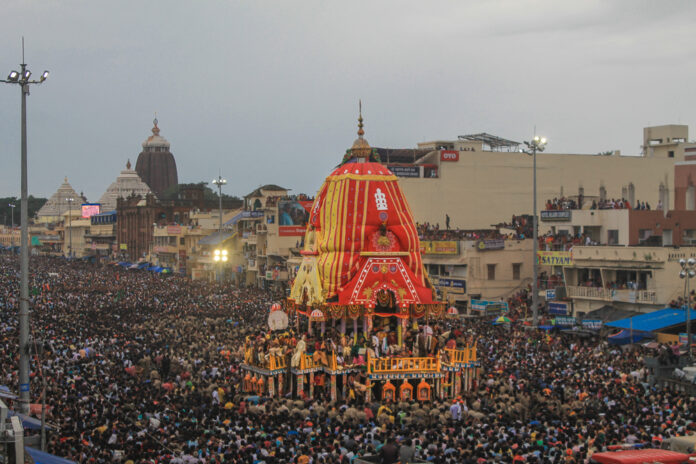Table of Contents
TogglePuri Jagannath Rath Yatra 2024
The Puri Jagannath Rath Yatra is one of the most grandiose and significant festivals in India, celebrated with great enthusiasm and devotion. Every year, millions of devotees gather in the holy city of Puri, Odisha, to participate in this spectacular event. The Rath Yatra, also known as the Chariot Festival, is dedicated to Lord Jagannath and is a time when the deities come out of their temple sanctum to give darshan to the masses. In this blog, we will delve into the history, significance, dates, timings, route map, chariots, celebrations, and the deities worshiped during the Rath Yatra 2024.
Puri Jagannath Rath Yatra History
The Puri Jagannath Rath Yatra history is rich and ancient that dates back centuries. The festival is deeply rooted in Hindu mythology and tradition. According to legends, the festival commemorates Lord Jagannath’s annual visit to his birthplace, the Gundicha Temple, located about 2 kilometers from the main Jagannath Temple.
- The tradition of Rath Yatra is believed to have started in the 12th century.
- The festival symbolizes the journey of Lord Krishna (Jagannath) from Gokul to Mathura.
- Historical records indicate that the Rath Yatra was initially celebrated during the reign of King Anantavarman Chodaganga Deva, who constructed the present-day Jagannath Temple.
Significance of Rath Yatra 2024
The Rath Yatra holds immense religious significance for Hindus, especially the followers of the Vaishnavism sect.
- It is the only time of the year when the deities—Lord Jagannath, his brother Balabhadra, and sister Subhadra—leave the sanctum of the temple.
- The festival signifies the journey of life and the movement of the divine through the earthly realm.
- It is believed that pulling the chariots of the deities brings immense spiritual merit.
- The event promotes the idea of unity and equality as people from all walks of life come together to celebrate.
Puri Jagannath Rath Yatra 2024 Date
The Puri Jagannath Rath Yatra follows the traditional Hindu lunar calendar, which means the dates vary each year. For 2024, the festival is scheduled as follows:
- Start Date: June 29th, 2024 (Rath Yatra Day)
- End Date: July 07th, 2024 (Bahuda Yatra – the return journey)
Jagannath Puri Rath Yatra 2024 Timings
The Rath Yatra is a meticulously timed event with rituals and ceremonies that span several days. The key timings for the 2024 Rath Yatra are:
- Mangaraja Bije (Anointed Ceremony): Early morning
- Pahandi Bije (Procession to the Chariots): Around 9 AM
- Chhera Pahanra (Sweeping of the Chariots by the King): Around 11 AM
- Pulling of the Chariots: Post noon, approximately around 2 PM
How is Rath Yatra Festival Celebrated?
The Puri Jagannath Rath Yatra is not only a visually captivating event but also rich in rituals and traditions that have been followed for centuries. These rituals are performed with great reverence and play a crucial role in the overall celebration of the festival. Here are some of the key rituals associated with the Rath Yatra:
Snana Purnima
- Date: Approximately 15 days before Rath Yatra
- Ritual: The deities—Lord Jagannath, Lord Balabhadra, and Goddess Subhadra—are bathed with 108 pitchers of scented water drawn from the golden well situated within the Jagannath Temple premises.
- Significance: This ritual signifies the purification and sanctification of the deities before they embark on their journey.
Anasara
- Duration: Following Snana Purnima, the deities remain in isolation for 15 days.
- Ritual: During this period, the deities are believed to be unwell and are kept away from public view. Special healing rituals and herbal treatments are performed.
- Significance: The period symbolizes the human-like aspects of the deities, emphasizing their connection to their devotees.
Netrotsava (Nava Yauvana Darshana)
- Date: A day before Rath Yatra
- Ritual: After the Anasara period, the deities regain their youth and fresh look. The ritual involves painting the eyes of the deities.
- Significance: This ceremony is also known as “Nava Yauvana” (new youth) and marks the deities’ rejuvenation.
Pahandi Bije
- Date: Rath Yatra day
- Ritual: The deities are carried out of the temple in a grand procession known as Pahandi. The deities are taken one by one to their respective chariots.
- Significance: The procession represents the movement of the divine from the temple sanctum to the chariots, making the gods accessible to all devotees.
Chhera Pahanra
- Ritual: The Gajapati King of Puri performs the Chhera Pahanra ritual, which involves sweeping the chariots with a golden broom and sprinkling holy water and sandalwood paste.
- Significance: This act signifies that even the king is a humble servant of the gods and emphasizes the theme of equality and humility.
Pulling of the Chariots
- Ritual: Devotees pull the three grand chariots—Nandighosa (Jagannath’s chariot), Taladhwaja (Balabhadra’s chariot), and Darpadalana (Subhadra’s chariot)—from the Jagannath Temple to the Gundicha Temple.
- Significance: Pulling the chariots is considered an act of great piety and is believed to cleanse sins and bring blessings.
Gundicha Temple Stay
- Duration: The deities stay at the Gundicha Temple for seven days.
- Ritual: During their stay, various rituals and ceremonies are conducted, and devotees throng to the temple to offer their prayers.
- Significance: The stay symbolizes the visit of Lord Jagannath to his birthplace, the Gundicha Temple.
Hera Panchami
- Date: Five days after Rath Yatra
- Ritual: Goddess Lakshmi, the consort of Lord Jagannath, visits the Gundicha Temple to remind Lord Jagannath to return to their abode.
- Significance: This ritual highlights the divine play between the gods and adds a unique dimension to the festivities.
Bahuda Yatra
- Date: The return journey of the deities, usually nine days after the start of the Rath Yatra.
- Ritual: The deities’ chariots are pulled back to the Jagannath Temple from the Gundicha Temple.
- Significance: This return journey is equally celebrated and marks the conclusion of the Rath Yatra festival.
Suna Besha
- Date: The day after Bahuda Yatra
- Ritual: The deities are adorned with gold ornaments and attire, known as Suna Besha (Golden Attire).
- Significance: This grand decoration signifies the gods’ opulence and is a major attraction for devotees.
Adhara Pana
- Date: A day after Suna Besha
- Ritual: The deities are offered a special drink called Adhara Pana, which is poured in large pots and placed on the chariots.
- Significance: The drink is meant to quench the deities’ thirst after their long journey, symbolizing care and devotion.
Niladri Bije
- Date: The final ritual of the Rath Yatra
- Ritual: The deities return to the sanctum of the Jagannath Temple.
- Significance: This marks the end of the Rath Yatra, with the deities being welcomed back to their divine abode.
These rituals, each with its own significance and symbolism, collectively make the Puri Jagannath Rath Yatra a profound spiritual and cultural experience. Devotees from all over the world participate in these rituals, reinforcing their faith and devotion.
Puri Jagannath Rath Yatra 2024 Route Map
The route of the Rath Yatra is a significant part of the festival. The chariots travel from the Jagannath Temple to the Gundicha Temple, passing through the Bada Danda (Grand Road).
- Starting Point: Jagannath Temple
- Key Stops:
- Mausi Maa Temple (Aunt’s temple) where the deities are offered Poda Pitha (a special type of cake)
- Gundicha Temple, the final destination
- Return Journey (Bahuda Yatra): The deities stay at the Gundicha Temple for seven days before returning to the Jagannath Temple, retracing the same route.
Puri Jagannath Rath Yatra 2024 Chariots
The Rath Yatra is famed for its grand and beautifully decorated chariots. Each deity has a dedicated chariot with specific characteristics.
- Nandighosa: The chariot of Lord Jagannath
- Height: Approximately 45 feet
- Number of wheels: 16
- Color: Red and yellow
- Features: The chariot is decorated with a variety of traditional motifs and symbols.
- Taladhwaja: The chariot of Lord Balabhadra
- Height: Approximately 44 feet
- Number of wheels: 14
- Color: Red and green
- Features: The chariot is adorned with numerous ornaments and designs reflecting the deity’s attributes.
- Darpadalana: The chariot of Goddess Subhadra
- Height: Approximately 43 feet
- Number of wheels: 12
- Color: Red and black
- Features: This chariot is beautifully decorated, representing the feminine energy of the goddess.
Puri Jagannath Rath Yatra 2024 Celebrations
The celebrations of the Rath Yatra are grand and vibrant, involving various rituals, cultural performances, and devotional activities.
- Rituals:
- The deities are brought out of the temple in a grand procession called Pahandi.
- The Chhera Pahanra ritual, where the Gajapati King of Puri sweeps the chariots with a golden broom, signifies humility before the divine.
- Cultural Performances:
- Traditional Odissi dance and music performances add to the festive spirit.
- Folk dances and performances by local artists are held along the procession route.
- Devotional Activities:
- Devotees sing bhajans (devotional songs) and kirtans (chanting).
- Prasad (holy offering) is distributed among the devotees.
Gods Worshiped During Rath Yatra 2024
The central deities worshiped during the Rath Yatra are Lord Jagannath, Lord Balabhadra, and Goddess Subhadra.
- Lord Jagannath:
- Considered an incarnation of Lord Vishnu, specifically Lord Krishna.
- Represents the universal and compassionate form of the divine.
- Lord Balabhadra:
- Also known as Balram, the elder brother of Lord Krishna.
- Symbolizes strength and protection.
- Goddess Subhadra:
- The sister of Lord Jagannath and Lord Balabhadra.
- Represents auspiciousness and well-being.
How to Reach Puri Jagannath Rath Yatra 2024
Attending the Puri Jagannath Rath Yatra is a spiritually enriching experience, attracting millions of devotees and tourists from around the world. If you are planning to witness the grandeur of this festival in 2024, it is essential to know how to reach Puri. Here is a detailed guide on the various modes of transportation available to reach Puri for the Rath Yatra.
By Air
- Nearest Airport: Biju Patnaik International Airport, Bhubaneswar (BBI)
- Distance to Puri: Approximately 60 kilometers
- Domestic Connectivity: Direct flights from major Indian cities such as Delhi, Mumbai, Kolkata, Chennai, Hyderabad, and Bangalore.
- International Connectivity: Limited direct flights; major international flights connect via Delhi or Mumbai.
- How to Reach Puri from the Airport:
- Taxi/Cab: Prepaid taxis and app-based cab services (like Ola and Uber) are available at the airport.
- Bus: State-run and private buses operate between Bhubaneswar and Puri.
- Train: Bhubaneswar Railway Station is well-connected to Puri; you can take a taxi from the airport to the railway station and then a train to Puri.
By Train
- Puri Railway Station (PURI):
- Connectivity: Direct trains from major cities like Delhi, Mumbai, Kolkata, Chennai, Hyderabad, Bangalore, and Ahmedabad.
- Popular Trains:
- Purushottam Express (Delhi to Puri)
- Neelachal Express (New Delhi to Puri)
- Howrah-Puri Express (Kolkata to Puri)
- Yesvantpur-Puri Express (Bangalore to Puri)
- Facilities: The station is equipped with waiting rooms, food stalls, and prepaid taxi services.
By Road
- Road Connectivity: Puri is well-connected by road to various cities and towns in Odisha and neighboring states.
- From Bhubaneswar: 60 kilometers via NH316
- From Kolkata: 495 kilometers via NH16 and NH316
- From Visakhapatnam: 450 kilometers via NH16
- Bus Services:
- State Transport: Odisha State Road Transport Corporation (OSRTC) operates regular bus services to Puri.
- Private Operators: Numerous private bus operators provide services, including Volvo and luxury buses.
Also, you can easily make Puri bus ticket booking on AbhiBus and attend the Rath Yatra 2024. Here are some of the most traveled bus routed by people to reach Puri.
- Kolkata to Puri bus booking
- Asansol to Puri bus booking
- Durgapur to Puri bus booking
- Kharagpur to Puri bus booking
By Sea
- Nearest Port: Paradip Port
- Distance to Puri: Approximately 95 kilometers
- Mode of Travel: While traveling by sea is not a common way to reach Puri, those arriving at Paradip Port can hire taxis or take buses to reach Puri.
Local Transportation in Puri
Once you reach Puri, getting around the city and accessing the Rath Yatra venues is facilitated by various local transportation options:
- Auto Rickshaws: Widely available for short distances.
- Cycle Rickshaws: Eco-friendly and a leisurely way to explore the city.
- Taxis/Cabs: Available for hire; app-based services may also operate.
- Buses: Local buses ply on major routes and can be used to reach the Jagannath Temple and other key areas.
- Bicycles/Motorbikes: Rentals are available for those who prefer exploring on two wheels.
Accommodation Tips
Given the influx of visitors during the Rath Yatra, it is advisable to book your accommodation well in advance. Puri offers a range of options, from budget lodges to luxury hotels and guest houses. Many accommodations are located near the Jagannath Temple and the Bada Danda (Grand Road), providing easy access to the Rath Yatra events.
Travel Tips for Rath Yatra 2024
- Advance Planning: Book your transportation and accommodation early to avoid last-minute hassles.
- Local Guidance: Seek information and guidance from local authorities and tourism offices for smooth travel.
- Health Precautions: Carry essential medications and stay hydrated, especially given the large crowds and potential weather conditions.
- Respect Local Customs: Follow local customs and traditions, particularly when visiting temples and participating in religious activities.
By choosing the most convenient mode of travel and planning ahead, you can ensure a memorable and spiritually fulfilling experience at the Puri Jagannath Rath Yatra 2024.
FAQs on Puri Jagannath Rath Yatra
Why is Rath Yatra Celebrated?
Rath Yatra, also known as the Chariot Festival, is celebrated to commemorate the annual journey of Lord Jagannath, along with his siblings Lord Balabhadra and Goddess Subhadra, from their abode in the Jagannath Temple to the Gundicha Temple, which is believed to be the home of their aunt. This journey symbolizes the return of Lord Krishna (Jagannath) to his birthplace in Vrindavan. The festival represents themes of unity, equality, and the devotion of the Lord towards his devotees, who get a rare opportunity to see and serve the deities outside their temple sanctum. The Rath Yatra also emphasizes the human aspects of the deities, such as their need for rest, purification, and rejuvenation.
How many days does Rath Yatra last in 2024?
The Rath Yatra festival in 2024 lasts for 9 days, starting on June 29th and concluding on July 07th with the return journey known as Bahuda Yatra.
Where is the largest Rath Yatra held?
The largest Rath Yatra is held in Puri, Odisha, at the Jagannath Temple.
When is Ulta Rath Yatra in 2024?
The Ulta Rath Yatra, also known as Bahuda Yatra, in 2024 is on July 16.
Who are the three deities worshiped during Rath Yatra?
The three deities worshiped during the Rath Yatra are Lord Jagannath, Lord Balabhadra, and Goddess Subhadra.
How long does the Rath Yatra festival last?
The Rath Yatra festival lasts for 9 days.
What is the distance covered during Rath Yatra in Puri?
The Rath Yatra covers a distance of approximately 2 kilometers from the Jagannath Temple to the Gundicha Temple in Puri.
How much time does it take for darshan at Jagannath Puri?
The time taken for darshan at Jagannath Puri can vary widely, but it generally takes around 1 to 2 hours, depending on the crowd.
Who constructed the Puri Jagannath Temple?
The Puri Jagannath Temple was constructed by King Anantavarman Chodaganga Deva in the 12th century.
Why is the Jagannath Temple closed for 14 days?
The Jagannath Temple is closed for 14 days after the Snana Purnima ritual, during which the deities are believed to be unwell and undergo healing treatments in a period known as Anasara.
What is the significance of the 22 steps in the Jagannath Temple?
The 22 steps, known as “Baisi Pahacha,” symbolize the various elements of human life and spiritual journey. Devotees believe climbing these steps cleanses sins and brings spiritual merit.
Why does the Jagannath Temple have no shadow?
The Jagannath Temple’s main structure is designed in such a way that it casts no shadow at any time of the day. This architectural marvel adds to the mystical aura of the temple, though the exact reason remains a matter of speculation and legend.
Conclusion
The Puri Jagannath Rath Yatra 2024 promises to be a mesmerizing spectacle of devotion, culture, and unity. As millions gather to witness and participate in this divine journey, the festival strengthens spiritual bonds and celebrates India’s rich cultural heritage. Whether you are a devout follower or a curious traveler, the Rath Yatra experience leaves an indelible mark on your soul. Plan your visit to Puri and be a part of this extraordinary celebration that brings together the earthly and the divine in a harmonious embrace.





